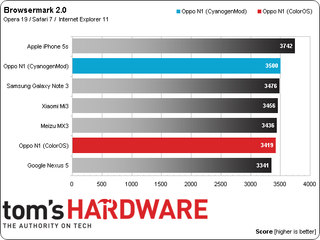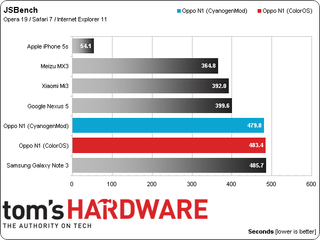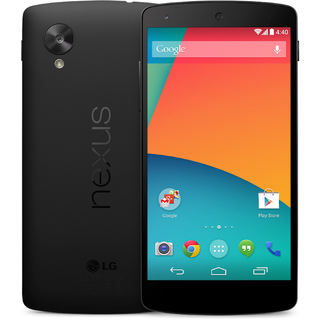Oppo N1 Review: Future-Looking Phablet Or Oversized Flop?
Oppo's N1 sports a unique pivoting camera, a large-format display, and two different operating system options. Are those features enough to make up for an older hardware platform and dicey software optimization in a sea of compelling competition?
Why you can trust Tom's Hardware
Results: Web Benchmarks
The tests on this page are JavaScript- and HTML5-heavy selections from our Web Browser Grand Prix series. Such tests are extremely meaningful to mobile devices because so much of the in-app content is served via the platform's native Web browser. These tests not only offer a view of each device’s Web browsing performance, but since these tasks are traditionally so CPU-dependent, browser benchmarks (especially JavaScript-heavy tests) are a great way to measure SoC performance between devices using the same platform and browser.
In order to keep the browser version even across all Android devices, we're employing a static version of the Chromium-based Opera on that operating system. Due to platform restrictions, Safari is the best choice for iOS based devices, while Internet Explorer is the only game in town on Windows RT.
Browsermark 2.0
Rightware’s Browsermark 2.0 is a synthetic browsing benchmark that tests several performance metrics, including load time, CSS, DOM, HTML5 Canvas, JavaScript, and WebGL.
While we realize that Browsermark 2.1 is now out, the newer version seems to have issues completing on several of our reference handsets, so we’ll continue to run version 2.0 for the time being.

The iPhone 5s easily wins the first Web browsing benchmark. Since the browser tests aren’t heavily threaded, the quad-core SoC’s main advantage over the A7 is nullified. Due to its higher IPC and strong integer performance, the A7 is likely to dominate all of the browsing tests.
Impressively, the Oppo N1 with CyanogenMod comes in second, again placing ahead of ColorOS, albeit by a mere two percentage points.
The one outlier in this benchmark is the Nexus 5. In the other CPU-centric tests, it places near the top. However, in this benchmark, it drops all the way to the bottom of the chart. That sounds worse than it really is, though. The difference between it and the highest-scoring Android device is less than five percent.
JSBench
Unlike most JavaScript performance benchmarks, JSBench could almost be considered real-world, since it utilizes actual snippets of JavaScript from Amazon, Google, Facebook, Twitter, and Yahoo!.

After running this benchmark on the iPhone 5s, I asked Siri how winning JSBench felt, and she smugly replied “Exactly 6.74 times better than coming in second place. I think I look good wearing gold, don’t you?”
The Cortex-A15 finds a way to propel the Meizu MX3 and Xiaomi Mi3 ahead of the Krait 400-based phones by a small margin, reversing the trend seen on the previous page. The N1's slower Krait 300 cores relegate the phone to last place, with no discernible difference between the two OS choices. Samsung's underclocked Note 3 matches the performance of the N1's Snapdragon 600 SoC.
Peacekeeper 2.0
Peacekeeper is a synthetic Javascript performance benchmark from Futuremark.

The iPhone 5s continues its winning ways, while the Nexus 5, Meizu MX3, and Xiaomi Mi3 group together in second place, narrowing the iPhone’s margin of victory to less than two.
The Note 3 slides down the chart to nearly tie with the N1, both devices performing about 40 percent slower than the Nexus 5.
WebXPRT 2013
Principled Technologies' WebXPRT is an HTML5-based benchmark that simulates common productivity tasks traditionally handled by locally-installed applications, including: photo editing, financial charting, and offline notetaking.

There’s no change at the top of the chart. The iPhone 5s finishes with a clean sweep of the Web browsing benchmarks.
The Nexus 5 is the best of the rest. Oppo's N1 puts in a strong performance, actually posting a better score than the more powerful Note 3. In fact, the Note 3 consistently underperforms in Web browsing, behaving more like the Snapdragon 600-powered N1 rather than the Nexus 5.
As for the N1, it’s worth mentioning that for Web browsing, there’s effectively no performance difference between CyanogenMod and ColorOS. This isn’t too surprising given the single-core emphasis of browsing benchmarks. Our CPU tests show that CyanogenMod only has an advantage when multiple cores are utilized.
Current page: Results: Web Benchmarks
Prev Page Results: CPU Core Benchmarks Next Page Results: GPU Core BenchmarksStay on the Cutting Edge
Join the experts who read Tom's Hardware for the inside track on enthusiast PC tech news — and have for over 25 years. We'll send breaking news and in-depth reviews of CPUs, GPUs, AI, maker hardware and more straight to your inbox.
-
wavetrex Just a small comment about OLED, even if this might not be the place to write about it.Reply
Probably due to to imperfections in the transistors that control the OLED pixels, there is a very faint but perceptible in deep darkness leakage of energy toward the pixels.
Yes, doesn't compare to the obvious light bleed of any TFT display, but the OLED "off" pixels are not truly off, they have a 0.00something-small level of light which could theoretically be measured by some very sensitive equipment.
The eyes are certainly capable of seeing it... -
InvalidError Putting both flash LEDs on the same side so close to the image sensor seems like a missed opportunity to me: putting one LED close to each hinge with the camera in the middle would provide more even lighting and softer shadows.Reply
With the mostly passable image quality, that would not help the N1 much though. -
Onus Please don't put the letters "p" "h" "a" "b" "l" "e" "t" together in that order and treat it like a word.Reply
-
WyomingKnott @onusReply
First time I read the term I had the image of holding my 10" Asus pad up to my face and talking into it. I suppose it's better than a shoe; cleaner, too. -
shahbaz200 Bad GPU, doesn't works well on this device, poor performance, other than that its good device.Reply -
BlankInsanity please respect my opinion, but I don't see why phones need to go bigger. i the 90s phones used to be huge and this was a problem for mobility and so as the years went by they created smaller form factor phones. Now here we are repeating that mistake. A phone is ment to make a small footprint when hidden on it's user such as a pocket. You don't put your tablet in your pocket, I don't see why'd you make a phone out of it. this is just my opinionReply -
jankeke "please respect my opinion, but I don't see why phones need to go bigger. i the 90s phones used to be huge and this was a problem for mobility and so as the years went by they created smaller form factor phones. Now here we are repeating that mistake. A phone is ment to make a small footprint when hidden on it's user such as a pocket. You don't put your tablet in your pocket, I don't see why'd you make a phone out of it. this is just my opinion "Reply
True but people couldn't watch porn on their phones back then so it made sense to make them as small as possible. Not so now ... ^^ -
Matthew DiGiacomo No offense Tom's Hardware but why are you reviewing this phone now? It's outdated and been on the market for almost 8 months.. No one really cares about it anymore.Reply -
falchard The Camera is a smart solution meaning you won't need 2 cameras. Obviously it will need tilt support to tell it which direction is up.Reply
No removable battery is a shitty solution. Its the issue all phones face after 2 years, their batteries no longer hold a charge. -
BlankInsanity Reply13717317 said:The Camera is a smart solution meaning you won't need 2 cameras. Obviously it will need tilt support to tell it which direction is up.
No removable battery is a shitty solution. Its the issue all phones face after 2 years, their batteries no longer hold a charge.
lol that's a scam the companies do to force you to buy a new one ;)



